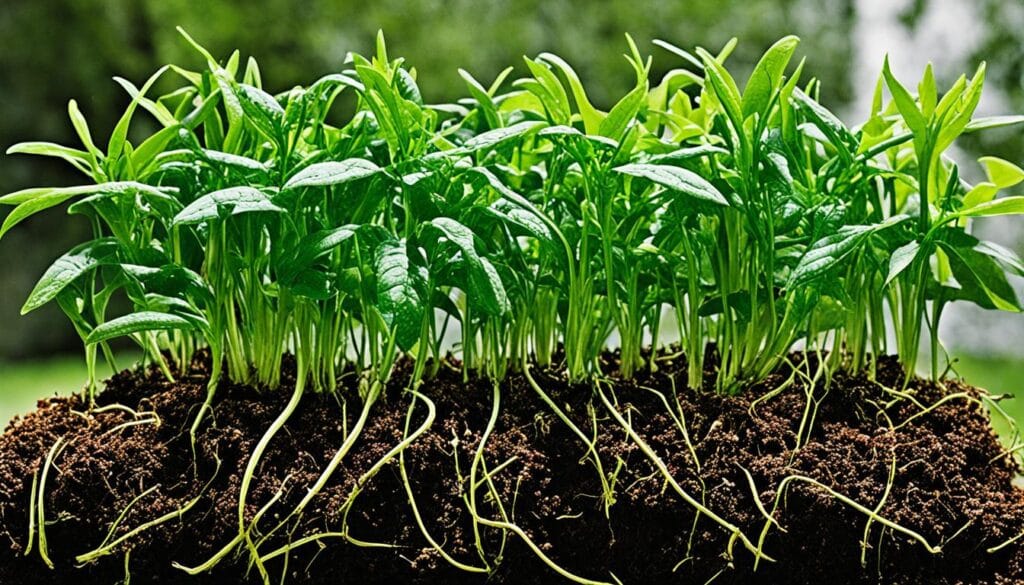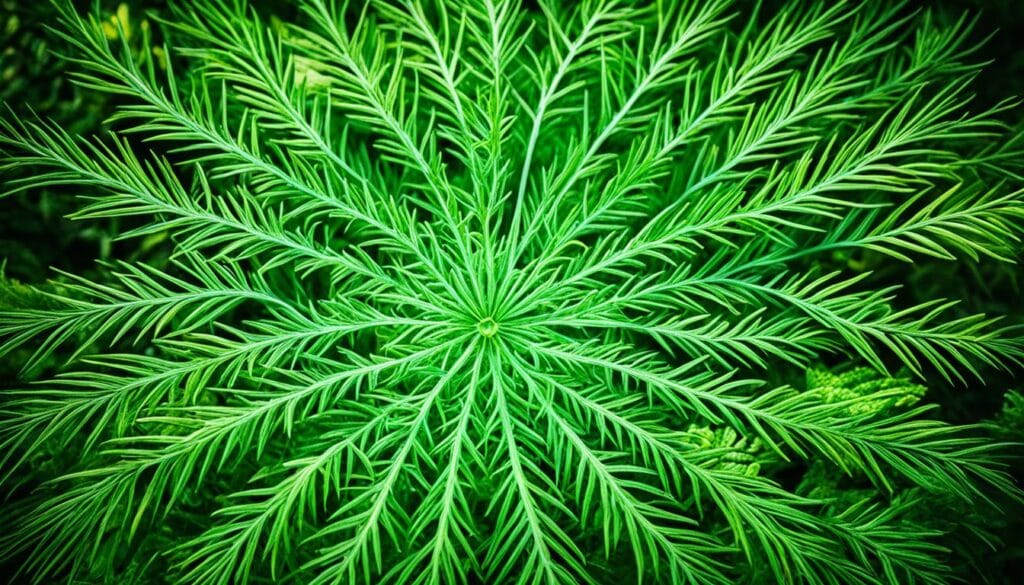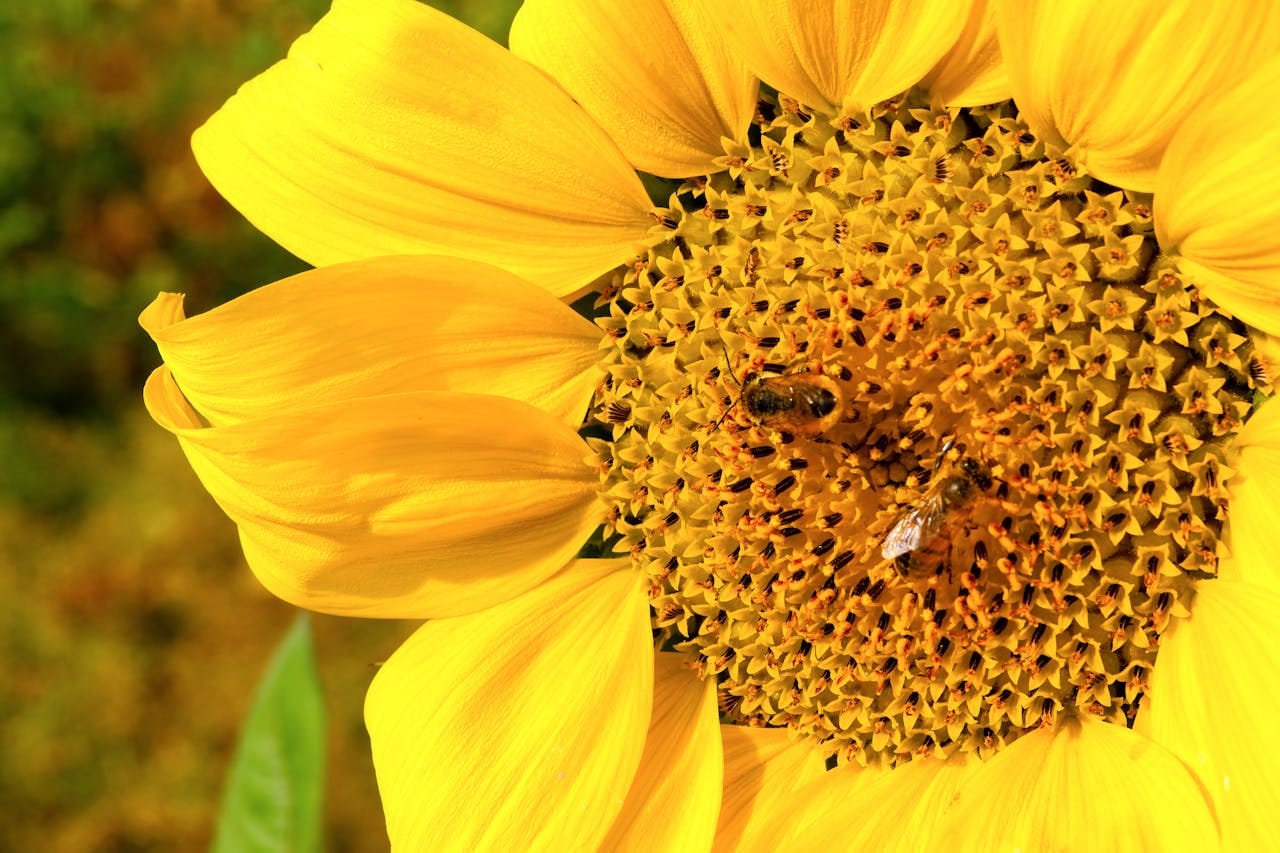The plant kingdom is full of amazing and surprising things. Plants can talk to each other and even recognize their family. They have tricks and ways to adapt that amaze us. By learning about extraordinary facts about plants, plant biology wonders, and botanical marvels, we can better appreciate the astonishing flora revelations, nature’s greenery gems, and the mind-blowing phytological phenomena in the incredible plant kingdom secrets and remarkable vegetative world insights.
This article reveals astounding botany trivia that shows the hidden sides of plants. Get ready to be amazed by the natural world and the botanical marvels around us.
Plants Communicate with Each Other
Many think plants just sit there, but they actually talk to each other. They use chemical signals in their roots to share info. This lets them work together and share things like carbon with each other.
Secreting Chemicals and Sharing Resources
Plants know their siblings and give them more resources. This is called plant resource sharing. It happens through botanical networks and botanical symbiosis underground. Plants warn each other about dangers like insects, helping them defend together.
Some plants might even talk to each other through sound. Corn seedlings make clicking noises and react to similar sounds. Tomatoes and blueberries can hear bees coming and release pollen just in time. This shows they have a good sense of their surroundings.

These discoveries change how we see plants. They’re not just sitting there; they’re active, sensing, and even talking to each other. By studying how plants communicate, we’re learning more about their complex world.
Plants Recognize and Favor Their Siblings
Biologists have found something amazing about plants. They prefer their siblings over strangers of the same type. This is called plant kin recognition. It shows that plants have a complex way of interacting within their families.
A study on the annual plant Cakile edentula showed interesting results. When strangers were planted together, they fought for resources. But when siblings were together, they didn’t compete. This shows that plants know and prefer their plant siblings.
This changes how we see plants. They’re not just simple organisms. They have a deep understanding of plant kin recognition and botanical family dynamics.
This research is important for understanding plant life. It shows us how plants interact and communicate with each other. It makes us think about the emotional and social lives of plants.

Plants being able to recognize and prefer their siblings is amazing. As we learn more about plant kin recognition and plant sibling preference, we’ll discover more about how plants communicate and compete.
Plants React to Sound
Plants are not just sitting there – they interact with their world in many ways, including sound. They can find water by feeling the vibrations of flowing water underground. Also, certain plants like sweet pepper and tomato grow better when they hear specific sounds.
Plant sound response and plant vibration sensing are key parts of how plants hear. For example, Arabidopsis plants make more mustard oils when they feel the vibrations of caterpillars. This makes them less tasty to pests.
But, plants don’t just react to any sound. They can tell the difference between the vibrations of caterpillars and gentle wind. This shows they have a special way to hear and respond to sounds. The study was in the journal Oecologia and shows how plants can hear and react to sounds.
Scientists are now studying how plants sense vibrations and what makes them respond. They want to know how these sounds work with other plant info to fight pests and diseases.
| Crop | Yield Increase with Acoustic Stimulation |
|---|---|
| Sweet Pepper | 63.05% |
| Tomato | 13.2% |
These findings show how plants are more complex than we thought. They highlight the role of botanical auditory perception in how plants interact with their world.

Extraordinary Facts About Plants
The natural world is full of amazing plant species. Each one has special adaptations and abilities that we often miss. From how they talk to each other to how they know when seasons change, plants amaze and inspire us. Let’s look at some amazing facts about these incredible beings.
Plants can sense gravity with special cells called statocytes. These cells move in response to gravity, helping the plant grow the right way. This plant gravity sensing is key for roots and stems to develop well.
Some plants, like certain orchids, have tricks to attract pollinators. They look or smell like female insects or rotting meat. This plant deceptive tactics helps them get pollinated without offering nectar or rewards.
When plants are under attack, they send out signals. These signals can bring in predators of the pests or parasitic wasps that attack the pests. This helps protect the plant from more damage.
Plants have internal clocks like humans do. These plant circadian rhythms control things like growth, flowering, and scent release. They help plants use energy wisely and get ready for different times of day.
Plants can tell when it’s a new season by sensing day length and temperature changes. This makes them produce seeds or flowers at the right time. It also helps them adjust to harsh winter conditions.
| Fascinating Plant Facts | Statistics |
|---|---|
| Identified Plant Species | More than 300,000 |
| Acorn Production in Oak Trees | Oak trees do not produce acorns until they are 50 years old |
| Water Storage in Baobab Trees | Baobab trees can store 1,000 to 120,000 litres of water in their trunks |
| Plant Life in the Ocean | More than 85% of plant life is found in the ocean |
| Oldest Living Tree Species | Gingko Biloba, dating back to about 250 million years ago |
These facts show how amazing plants are. They have incredible adaptations and abilities. As we learn more about nature, we’ll be more amazed by these silent, yet vital, parts of our world.

Strawberry’s Unique Seed Arrangement
The strawberry is a fascinating fruit in the rose family. It has a special seed arrangement that makes it stand out. It’s not a true berry but a “multiple fruit” with many small fruits in a fleshy base.
Strawberries are unique because their seeds are on the outside, unlike most fruits. Each strawberry has about 200 seeds in its fleshy base. This is a feature only found in this fruit.
This special seed arrangement shows the strawberry’s botanical traits. Being in the rose family, strawberries share traits like having many small fruits on a fleshy base. But, their seeds being on the outside make them stand out from other plants in the family.
The way strawberries have their seeds affects how they look and how they are grown and eaten. The seeds being on the outside makes eating strawberries easy without much prep. It also helps in harvesting and processing, making strawberries a favorite fruit.
In the U.S., people eat about 3.4 pounds of fresh strawberries each year. They also eat 1.8 pounds of frozen strawberries. Over 50% of kids between seven and nine pick strawberries as their top fruit. This shows how much people love the unique seeds of strawberries.

Longevity of Trees
Trees are among the longest-living things on Earth. Some, like the Great Basin Bristlecone Pine, are over 5,000 years old. Their long lives come from being able to last through time with special tree survival strategies.
One reason trees live so long is they don’t get old like most living things. They stay healthy and keep growing for centuries. This is different from many other creatures.
Another reason is that trees can have more than one trunk. This lets them replace old or damaged parts. They also store energy and make chemicals that keep pests away. This helps them live longer.
The oldest tree, the Methuselah, is a Great Basin Bristlecone Pine and is 4,852 years old. This shows how tough and adaptable these trees are. They’ve made it through many changes over thousands of years.
| Oldest Living Trees | Age (Years) | Location |
|---|---|---|
| Methuselah (Great Basin Bristlecone Pine) | 4,852 | California, USA |
| Prometheus (Great Basin Bristlecone Pine) | 4,862 | Nevada, USA |
| Llangernyw Yew | 4,000-5,000 | Conwy, Wales |
| General Sherman (Giant Sequoia) | 2,300-2,700 | California, USA |
These ancient trees show how resilient and adaptable they are. They’ve survived many changes over the centuries. By learning about what makes them live so long, we can see the value of these amazing trees.

Plants Sense Seasonal Changes
Plants have an amazing way to adjust to the seasons. They notice small changes in day length and temperature. This tells them when to make seeds or flowers and how to grow in harsh winter. This skill is called plant seasonal adaptation. It’s key to their health and strength.
Using Day Length and Temperature
Some plants, like certain flowers, know when to bloom or make seeds by watching the day length. As days get shorter in fall, they get ready for winter and the next growing season. Others change their growth based on temperature. They grow less in the cold and more when it gets warmer.
Studies now show how big of an effect botanical climate response has on plants. In the UK, flowers have started blooming a month earlier over the last 40 years. Hawthorns bloom 13 days earlier and horse chestnuts 10 days sooner than before.
A German study from 1980 to 2020 found that plants and their pollinators are moving their flowering times forward due to climate change. But not all insects are adapting the same way. Bees and butterflies are keeping up, but hoverflies are not. This makes us wonder about the future of plants and their pollinators.

As our climate changes, it’s important to understand how plants adjust to the seasons. Watching how plants and their friends change will help us learn about their strength and weaknesses. This knowledge is key to keeping our natural world healthy and diverse.
Plants Have Circadian Rhythms
Like humans, plants have an internal clock called plant circadian rhythms. These rhythms control growth, flowering, and scent release, all in sync with day and night. They help plants save energy and prepare for the day ahead.
Studies on plant internal clocks show that plants move with the sun to get the most from photosynthesis. They also release chemicals to fight off pests at specific times, making them less susceptible to damage.
Research says using plants’ natural rhythms can boost crop yields and fight pests better. It could also make crops more nutritious for us. By understanding and using plant circadian rhythms, we can make farming more sustainable and efficient.
| Fact | Description |
|---|---|
| Circadian Rhythms in Plants | Plants don’t sleep like us, but they have their own 24-hour cycles. These cycles help them adjust to day length, prepare for seasons, and optimize their functions. |
| Temperature Compensation | Plant circadian rhythms keep a steady cycle even when the temperature changes. |
| Genetic Basis | Charles and Francis Darwin found in 1880 that plant circadian rhythms are heritable. This means they have a genetic foundation. |
| Applications in Agriculture | Aligning plants’ internal clocks with their environment can lead to better growth and higher yields. Adjusting plant chemical signals by their rhythms could also boost productivity and nutritional value. |

Understanding plant circadian rhythms opens up new ways for sustainable and efficient farming. This could lead to less pest damage and more productive crops.
Plants Release Distress Signals
When plants face stress, like an attack from herbivores, they have a clever way to defend themselves. They release chemical signals into the air to call for help. These signals can draw in predators of the pests or parasitic wasps that lay eggs inside the herbivores. This helps protect the plant from more damage.
This is called “plant distress signaling.” It’s a complex way for plants to get help from other living things. Studies have found that when certain plants release chemical signals, they can make nearby plants stronger against diseases and change their genes.
Scientists used to doubt if plants could really talk to each other. But now, thanks to better experiments, we know they do send out chemical signals. As we learn more about how plants and herbivores interact, we see how plants can protect themselves by sending out distress signals.


